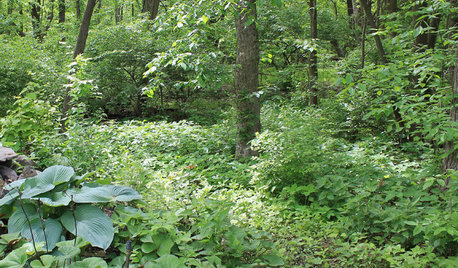Which trees are 'weed' trees?
indiancreeker
19 years ago
Featured Answer
Comments (41)
lycopus
19 years agoFlowerkitty
19 years agoRelated Discussions
which trees to double as shade tree in livestock pasture?
Comments (10)Thanks for all the thoughts and suggestions. I don't really know how hard cattle or other livestock would be on mature trees in other regions and management systems, but I know that lots of trees can survive the pressures of livestock in my system: in my pasture rotations (mostly along the edges but within the paddocks) I currently have a sycamore, pines, alders, red oaks, black walnuts, red cedars, and tulip-poplars, and they've all done fine. Tulip-poplars and red cedars seem like they might be harder to get through the earlier years but not too hard. I hadn't initially thought pecans for a few reasons. I'd be interested in hearing your thoughts on these issues. First, pecans are such a large tree that they'd give me more shade than I'd need for the animals, and I don't think I want that extra competition with the grass. Secondly, pecans seem like awfully small nuts to try to find in pasture-type grass. Would bush hogging be sufficient to get the grass down low enough to find most of the nuts? Thirdly, what about manure contamination? I would want the shade most of all in the summer. Could I let manure fall under the tree all summer and then safely harvest the nuts immediately afterwards? On the one hand, I figure I need tall trees to grow above the reach of the livestock, which would make a crop that fell to the ground practical, but on the other hand, there are the issues of manure and finding the crop in the grass, so that leads me to think relying on ladders might be a good compromise. Any suggestions for a particular mulberry cultivar? Some varieties seem to have more tree-like form than others. I think I'd want a tree with a trunk that went straight up beyond where cattle could reach and then formed its canopy. ORwoods, you mentioned figs. I do have some figs near my barn, and I've noticed when I've had animals on leads walking past my figs (or when they've gotten out of the fence) that they've never seemed interested in the fig bush. Are there specific varieties of figs that could better be trained to more tree-like form (as with the mulberry)? What about kaki persimmons? Would they even get big enough? Could I get extra height/trunk by grafting a kaki 6 foot high on a D.v. rootstock? Could that work?...See MoreWeeds in my Xeriscape - Pls ID tree/bush like weed!
Comments (2)They look like hackberry seedlings to me. The blog post I've linked has an excellent clickable picture of a hackberry seedling, it's the 9th picture down. Here is a link that might be useful: The Birth of Trees...See MoreInvasive weed/plant/tree; serrated spade leaves, runners
Comments (2)I think you nailed it. Sounds like liberal application of a chainsaw and herbicide is the solution. Will offer both to the new neighbor to nip it in the bud. Much appreciated! Marc...See MoreMulching under an Olive tree to prevent weeds
Comments (4)I think there is a spray you can apply to the tree when it's blooming to prevent olives. One way to harvest olives is to lay big sheets of burlap down when the first few have fallen, and shake the tree branches. It gets the worst of the fruit fall out of the way quickly. Well-packed gravel (decomposed granite, crushed rock of some sort) can work, because the olives are larger than the gravel bits. You rake them with a fine-tined rake or some sort of litter scoop....See Morejoepyeweed
19 years agotoo_many_pets
19 years agolycopus
19 years agoveronicastrum
19 years agotoo_many_pets
19 years agointheforest
19 years agobrenda_near_eno
19 years agohousosax
19 years agoElaine_NJ6
19 years agoFledgeling_
19 years agohomer_zn5
19 years agofairy_toadmother
19 years agocharleswrichard
18 years agopaalexan
18 years agoflowersandthings
18 years agobarton
18 years agochester_grant
18 years agoladyslppr
18 years agoterryr
18 years agowisconsitom
18 years agoScottReil_GD
18 years agomaifleur01
18 years agogirllovesdirtandbugs
18 years agogirllovesdirtandbugs
18 years agoradagast
18 years agonywoodsman
17 years agojoepyeweed
17 years agoFlowerkitty
17 years agoFlowerkitty
17 years agobrendan_of_bonsai
17 years agoebrathedebra
17 years agoturbo_tpl
17 years agoflorey
17 years agojoepyeweed
17 years agolonegreyrabbit
17 years agonywoodsman
17 years agoflorey
17 years agogardenparadise
16 years ago
Related Stories

GARDENING GUIDESHow to Keep Your Trees Healthy
Ensure your trees’ vigor for years to come with these tips for protecting roots, watering effectively and more
Full Story
HOUZZ TOURSHouzz Tour: From Overgrown Weeds to Picturesque Farmhouse Expanse
This once-neglected 100-acre South Carolina site now features a lake, a wood-filled farmhouse and a far-reaching view
Full Story
EDIBLE GARDENSNatural Ways to Get Rid of Weeds in Your Garden
Use these techniques to help prevent the spread of weeds and to learn about your soil
Full Story
GARDENING GUIDESGreat Design Plant: Bugle Weed, a Quick Ground Cover
It’s highly adaptable, suppresses weeds, reduces erosion and provide weeks of bright flowers. Just watch for invasiveness
Full Story
GARDENING GUIDES5 Ways to Naturally Win the Weed War
Show irksome weeds no mercy with these tricks for combating them sans chemicals
Full Story
GARDENING GUIDESWhat’s in a Name? See 6 Wildflowers That Aren’t ‘Weeds’ at All
Dispel the stereotypes of weeds and try these wildlife-supporting native wildflowers in your garden
Full Story
GARDENING GUIDESLet's Weed Out 4 Native Plant Myths
Plant wisely for a garden that supports pollinators and requires less work
Full Story
GARDENING GUIDESTackle Weeds the Natural Way
Instead of dousing your yard with chemicals to wipe out weeds, let time and nature work their magic via smothering and solarization
Full Story
LANDSCAPE DESIGNGarden Overhaul: Which Plants Should Stay, Which Should Go?
Learning how to inventory your plants is the first step in dealing with an overgrown landscape
Full Story
GARDENING GUIDESTree Care: Common Tree Diseases and What to Do About Them
Learn to recognize trees that may be affected by diseases or pests so you can quickly take action
Full StorySponsored
More Discussions




Fledgeling_